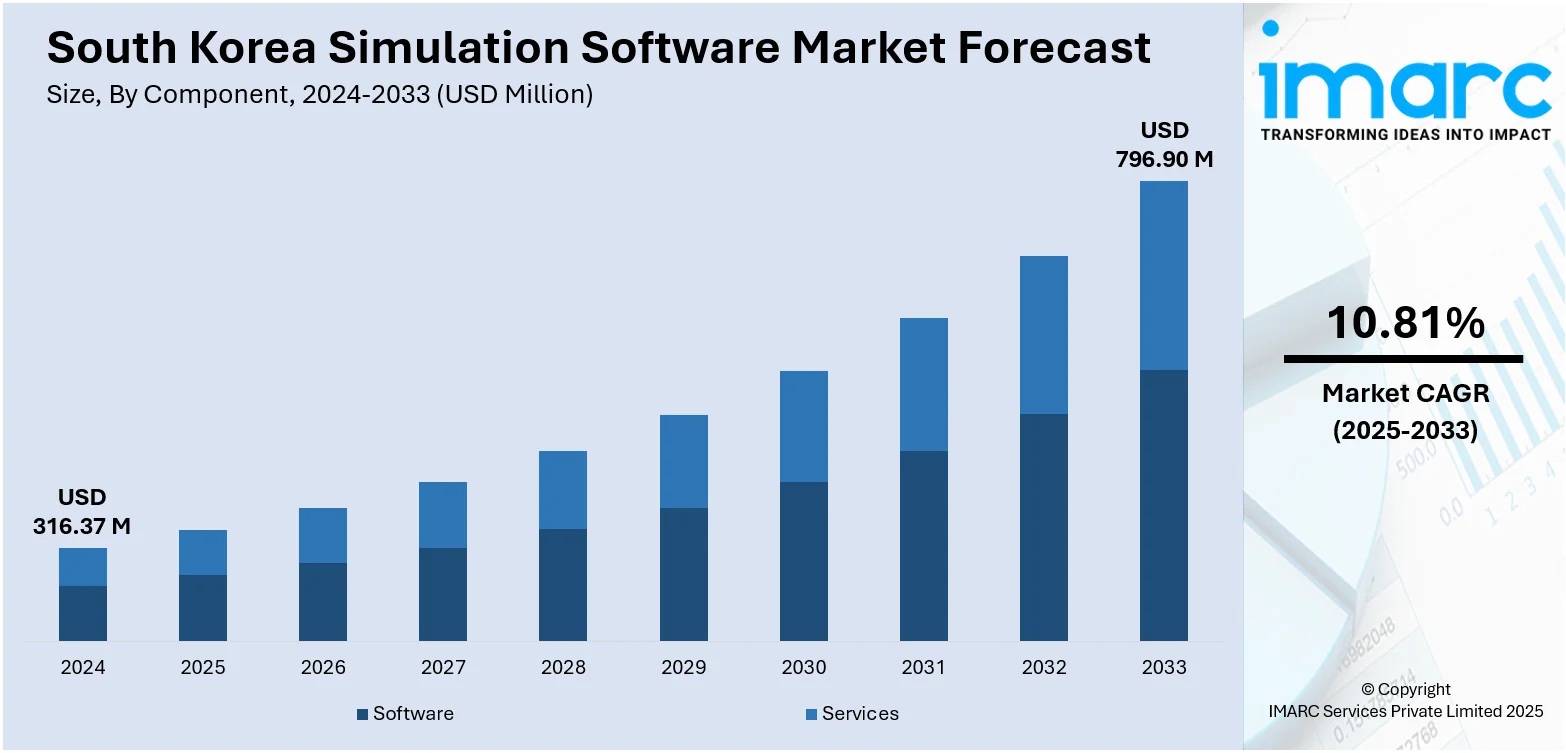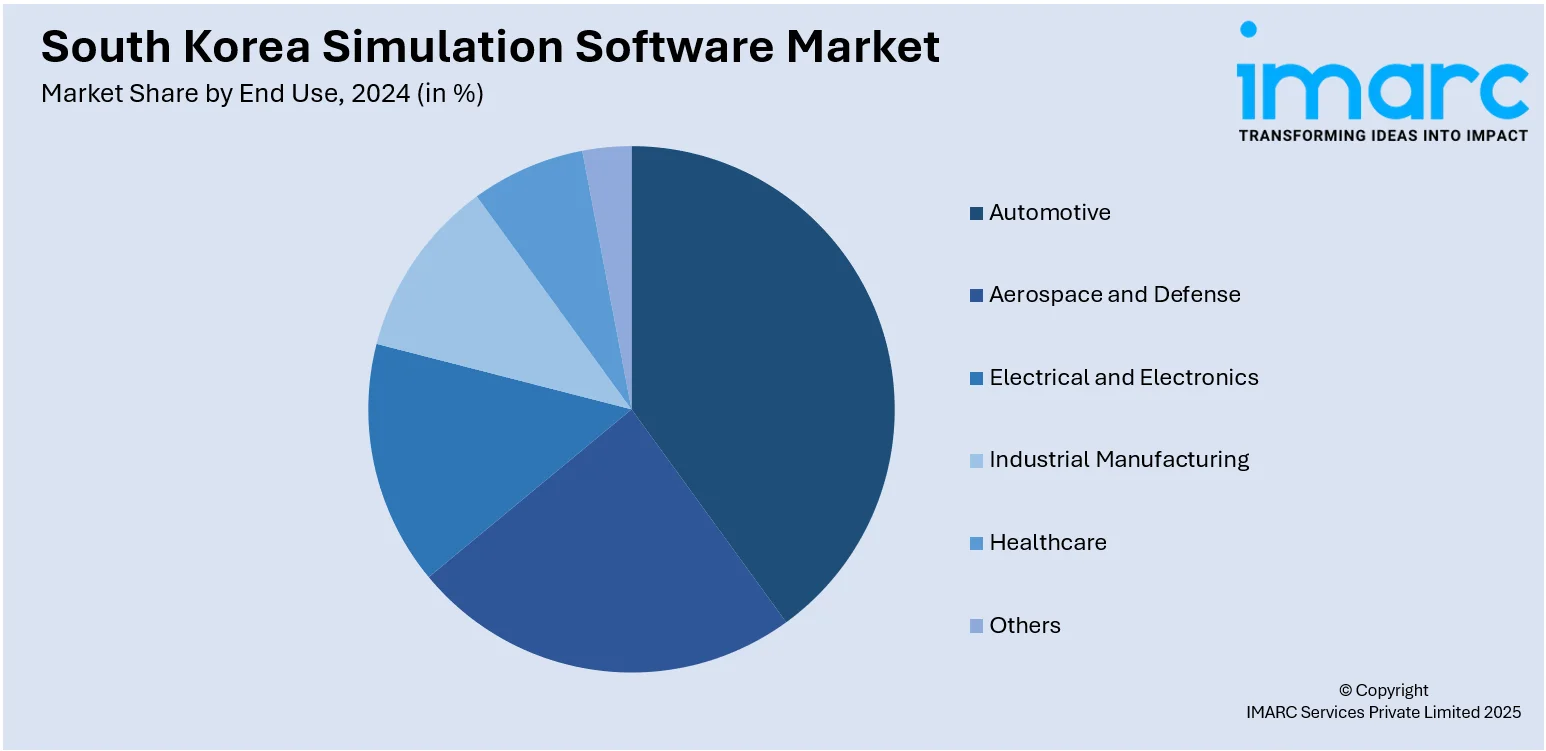
South Korea Simulation Software Market Size, Share, Trends and Forecast by Component, Deployment, End Use, and Region, 2025-2033
South Korea Simulation Software Market Overview:
The South Korea simulation software market size reached USD 316.37 Million in 2024. Looking forward, IMARC Group expects the market to reach USD 796.90 Million by 2033, exhibiting a growth rate (CAGR) of 10.81% during 2025-2033. The growing need for simulation software in South Korea is driven by rapid advancements in the automotive, nuclear, and energy sectors. These industries rely on simulation tools to enhance design, ensure safety, meet regulations, reduce costs, and support innovation, thereby increasing the South Korea simulation software market share.
|
Report Attribute
|
Key Statistics
|
|---|---|
|
Base Year
|
2024
|
|
Forecast Years
|
2025-2033
|
|
Historical Years
|
2019-2024
|
| Market Size in 2024 | USD 316.37 Million |
| Market Forecast in 2033 | USD 796.90 Million |
| Market Growth Rate 2025-2033 | 10.81% |
South Korea Simulation Software Market Trends:
Increasing Demand in Automotive Industry
With South Korean automakers concentrating on advancements in electric vehicles (EVs), self-driving technologies, and intelligent automotive systems, simulation software is becoming essential for developing, evaluating, and enhancing these sophisticated systems. Simulating vehicle performance, safety aspects, and user interactions is vital for achieving adherence to strict regulatory requirements and satisfying high-quality standards. Simulation tools also help assess intricate technologies and innovative production methods, which are vital to the advancing automotive industry. For instance, South Korea's vehicle electrification market is expected to expand at a compound annual growth rate (CAGR) of 11.21% from 2025 to 2033, indicating a rising transition towards electric transportation and the demand for improved simulation tools. These software tools assist manufacturers in decreasing time and expenses by allowing virtual evaluation and improvement of EV designs, safety features, and self-driving capabilities. With the automotive sector adopting advanced technologies and manufacturing techniques, the need for simulation software is growing. The continuous rise of South Korea's automotive industry, propelled by the demand for innovation and sustainability, is leading to considerable investments in simulation tools. The role of simulation in refining vehicle designs and optimizing manufacturing processes remains essential as South Korean automakers lead the way in global automotive advancements.

To get more information on this market, Request Sample
Advancements in Nuclear and Energy Sectors
The swift progress in the nuclear and energy industries is driving the need for simulation software in South Korea. As these sectors strive to guarantee the safety, efficiency, and adherence to regulations of intricate systems, simulation software is emerging as a vital resource in developing and evaluating new technologies. An important instance of this is the introduction of Korea Hydro & Nuclear Power (KHNP)’s first simulator for its Innovative Small Modular Reactor (i-SMR) in 2024. The simulator was an essential element in confirming the operational adequacy of the i-SMR. Set to be finished by mid-2027, this simulation tool will enhance the reactor’s basic design, offering crucial insights into its operational performance across different scenarios. This advancement highlights the growing dependence on simulation technologies to guarantee that nuclear power plants, especially novel and advanced models, adhere to strict safety and efficiency benchmarks. With South Korea's ongoing investment in energy innovation and nuclear technologies, the demand for sophisticated simulation software is rising. These software tools enable comprehensive design testing, minimizing risks linked to new energy technologies, promoting environmental sustainability, and improving operational efficiency in critical industries such as nuclear energy. This trend is significantly contributing to the South Korea simulation software market growth, as advanced tools become indispensable for supporting the nation's evolving energy and nuclear technology landscape.
South Korea Simulation Software Market Segmentation:
IMARC Group provides an analysis of the key trends in each segment of the market, along with forecasts at the country and regional levels for 2025-2033. Our report has categorized the market based on component, deployment, and end use.
Component Insights:
- Software
- Services
The report has provided a detailed breakup and analysis of the market based on the component. This includes software and services.
Deployment Insights:
- On-premises
- Cloud-based
A detailed breakup and analysis of the market based on the deployment have also been provided in the report. This includes on-premises and cloud-based.
End Use Insights:

- Automotive
- Aerospace and Defense
- Electrical and Electronics
- Industrial Manufacturing
- Healthcare
- Others
A detailed breakup and analysis of the market based on the end use have also been provided in the report. This includes automotive, aerospace and defense, electrical and electronics, industrial manufacturing, healthcare, and others.
Regional Insights:
- Seoul Capital Area
- Yeongnam (Southeastern Region)
- Honam (Southwestern Region)
- Hoseo (Central Region)
- Others
The report has also provided a comprehensive analysis of all the major regional markets, which include Seoul Capital Area, Yeongnam (Southeastern Region), Honam (Southwestern Region), Hoseo (Central Region), and others.
Competitive Landscape:
The market research report has also provided a comprehensive analysis of the competitive landscape. Competitive analysis such as market structure, key player positioning, top winning strategies, competitive dashboard, and company evaluation quadrant has been covered in the report. Also, detailed profiles of all major companies have been provided.
South Korea Simulation Software Market News:
- In June 2025, South Korea’s defense firm LIG Nex1 was contracted to develop a counter-ballistic missile simulation system worth 3.4 billion won, to be completed by 2028. The system will simulate the entire missile threat process to enhance training and response capabilities. It supports South Korea’s Three-Axis defense strategy against missile threats.
- In March 2025, Norma and Gyeongsang National University launched South Korea’s first quantum advantage project in aerospace to develop quantum algorithms for high-speed aerodynamics simulations. It targets solving complex equations faster than classical methods, positioning Korea as a quantum aerospace leader.
South Korea Simulation Software Market Report Coverage:
| Report Features | Details |
|---|---|
| Base Year of the Analysis | 2024 |
| Historical Period | 2019-2024 |
| Forecast Period | 2025-2033 |
| Units | Million USD |
| Scope of the Report |
Exploration of Historical Trends and Market Outlook, Industry Catalysts and Challenges, Segment-Wise Historical and Future Market Assessment:
|
| Components Covered | Software, Services |
| Deployments Covered | On-premises, Cloud-based |
| End Uses Covered | Automotive, Aerospace and Defense, Electrical and Electronics, Industrial Manufacturing, Healthcare, Others |
| Regions Covered | Seoul Capital Area, Yeongnam (Southeastern Region), Honam (Southwestern Region), Hoseo (Central Region), Others |
| Customization Scope | 10% Free Customization |
| Post-Sale Analyst Support | 10-12 Weeks |
| Delivery Format | PDF and Excel through Email (We can also provide the editable version of the report in PPT/Word format on special request) |
Key Questions Answered in This Report:
- How has the South Korea simulation software market performed so far and how will it perform in the coming years?
- What is the breakup of the South Korea simulation software market on the basis of component?
- What is the breakup of the South Korea simulation software market on the basis of deployment?
- What is the breakup of the South Korea simulation software market on the basis of end use?
- What is the breakup of the South Korea simulation software market on the basis of region?
- What are the various stages in the value chain of the South Korea simulation software market?
- What are the key driving factors and challenges in the South Korea simulation software market?
- What is the structure of the South Korea simulation software market and who are the key players?
- What is the degree of competition in the South Korea simulation software market?
Key Benefits for Stakeholders:
- IMARC’s industry report offers a comprehensive quantitative analysis of various market segments, historical and current market trends, market forecasts, and dynamics of the South Korea simulation software market from 2019-2033.
- The research report provides the latest information on the market drivers, challenges, and opportunities in the South Korea simulation software market.
- Porter's five forces analysis assist stakeholders in assessing the impact of new entrants, competitive rivalry, supplier power, buyer power, and the threat of substitution. It helps stakeholders to analyze the level of competition within the South Korea simulation software industry and its attractiveness.
- Competitive landscape allows stakeholders to understand their competitive environment and provides an insight into the current positions of key players in the market.
Need more help?
- Speak to our experienced analysts for insights on the current market scenarios.
- Include additional segments and countries to customize the report as per your requirement.
- Gain an unparalleled competitive advantage in your domain by understanding how to utilize the report and positively impacting your operations and revenue.
- For further assistance, please connect with our analysts.
 Request Customization
Request Customization
 Speak to an Analyst
Speak to an Analyst
 Request Brochure
Request Brochure
 Inquire Before Buying
Inquire Before Buying




.webp)




.webp)












